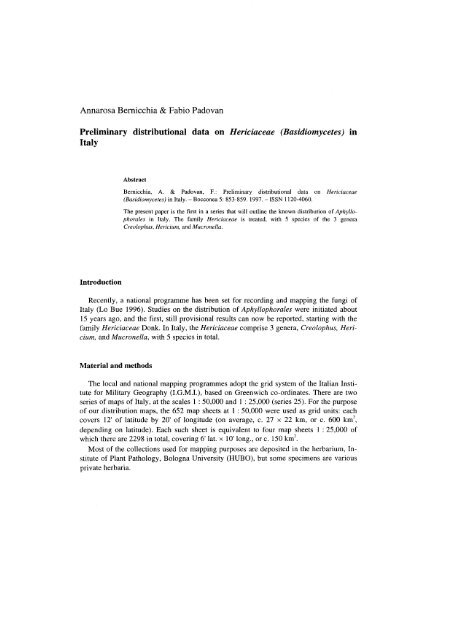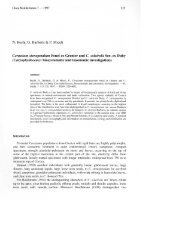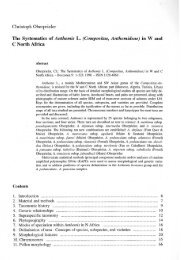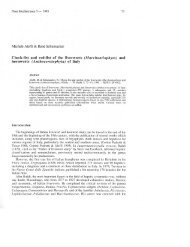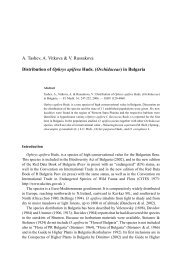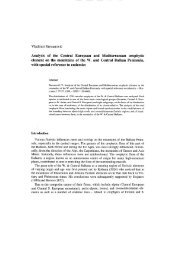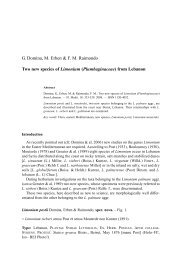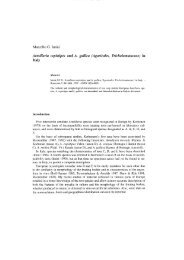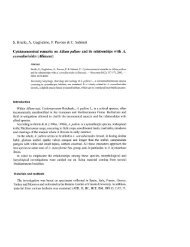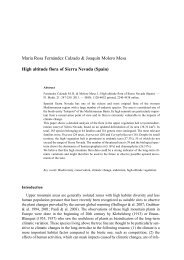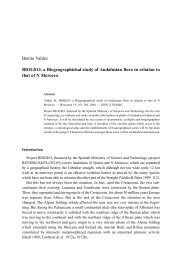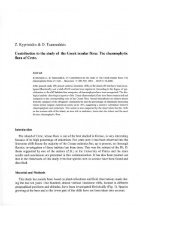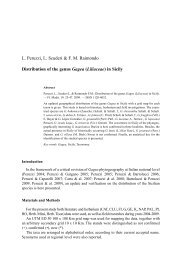Annarosa Bernicchia & Fabio Padovan Preliminary ... - Herbmedit.org
Annarosa Bernicchia & Fabio Padovan Preliminary ... - Herbmedit.org
Annarosa Bernicchia & Fabio Padovan Preliminary ... - Herbmedit.org
Create successful ePaper yourself
Turn your PDF publications into a flip-book with our unique Google optimized e-Paper software.
<strong>Annarosa</strong> <strong>Bernicchia</strong> & <strong>Fabio</strong> <strong>Padovan</strong><br />
<strong>Preliminary</strong> distributional data on Hericiaceae (Basidiomycetes) in<br />
Italy<br />
Introduction<br />
Abstract<br />
<strong>Bernicchia</strong>, A. & <strong>Padovan</strong>, F.: <strong>Preliminary</strong> distributional data on Hericiaceae<br />
(Basidiomycetes) in Italy. - Bocconea 5: 853-859.1997. - ISSN 1120-4060.<br />
The present paper is the first in a series that will outline the known distribution of Aphyllophorales<br />
in Italy. The family Hericiaceae is treated, with 5 species of the 3 genera<br />
Creolophus, Hericium, and Mucronella.<br />
Reeently, a national programme has been set for reeording and mapping the fungi of<br />
Italy (Lo Bue 1996). Studies on the distribution of Aphyllophorales were initiated about<br />
15 years ago, and the first, stili provisional results ean now be reported, starting with the<br />
family Hericiaceae Donk. In Italy, the Hericiaceae eomprise 3 genera, Creolophus, Hericium,<br />
and Mucronella, with 5 speeies in total.<br />
Material and methods<br />
The loeal and national mapping programmes adopt the grid system of the Italian Institute<br />
for Military Geography (I.G.M.I.), based on Greenwieh eo-ordinates. There are two<br />
series of maps of Italy, at the seales 1 : 50,000 and l : 25,000 (series 25). For the purpose<br />
of our distribution maps, the 652 map sheets at 1 : 50,000 were used as grid units: eaeh<br />
eovers 12' of latitude by 20' of longitude (on average, e. 27 x 22 km, or e. 600 km 2<br />
,<br />
depending on latitude). Eaeh sueh sheet is equivalent to four map sheets l : 25,000 of<br />
whieh there are 2298 in total, eovering 6' lat. x lO' long., or e. 150 km 2 •<br />
Most of the eolleetions used for mapping purposes are deposited in the herbarium, Institute<br />
of Plant Pathology, Bologna University (HUBO), but some speeimens are various<br />
private herbaria.
854 <strong>Bernicchia</strong> & <strong>Padovan</strong>: Distribution of Hericiaceae in Italy<br />
Fig. 1-5. Fruiting bodies ofItalian Hericiaceae. - l, Hericium alpestre; 2, Hericium coralloides; 3,<br />
Hericium erinaceum; 4, Creolophus cirrhatus; 5, Mucronella calva (photographs: 1, 4-5, F. <strong>Padovan</strong>;<br />
2, A. Zuccherelli; 3, S. Curreli).
Bocconea 5(2) - 1997 855<br />
Creolophus P. Karst.<br />
This genus is monotypic. Its onIy species, Creolophus cirrhatus (Pers.: Fr.) P. Karst., is<br />
unmistakable. It is wideIy distributed in Europe (Austria, Denmark, Finland, France,<br />
Gcrmany, Italy, Norway, and Sweden; see Jiilich 1989).<br />
Creolophus cirrhatus differs from the species of Hericium by its non-amyloid (IKI -)<br />
context and by dorsiventrally flattened fruiting bodies. In both genera, gloeocystidia are<br />
present (Maas Geesteranus 1962; Fig. 12). For a detailed description of macro- and<br />
microscopical characters, see Breitenbach & Krazlin (1986) and Jiilich (1989).<br />
The species is uncommon in ltaIy, where it is known to form multipileate basidiocarps,<br />
showing a sporadic distribution in some regions (Fig. 6). It appears to be mainly<br />
associated with Fagus sylvatica L. and has been found in beech forests or Fagus-Abies<br />
forests, from the end of the summer to winter time. It has been collected mostly on Fagus<br />
(7 times), but also once on Malus and once on Carpinus (Fig. 4). Two collections are<br />
deposited in HUBO, the others are in herb. Jamoni and the herbaria of the Gruppo Micologico<br />
di Bolzano and the Gruppo Micologico di Belluno.<br />
Hericium Perso<br />
Following Hallenberg (1983), we recognize three species in Europe: Hericium alpestre<br />
Pers., H. coralloides (Scop. : Fr.) Pers., and H. erinaceum (Bui!. : Fr.) Perso There has<br />
been much confusion over the correct application of the name H. coralloides. Traditionally<br />
the species growing on Fagus had been given that name. Then Maas Geesteranus<br />
(1959), followed by other authors, applied the binomial to the species growing on Abies in<br />
Centrai Europe, designating the species found on Fagus as H. clathroides (Pallas : Fr.)<br />
Perso This has changed again, with H. clathroides now being considered a synonym of H.<br />
coralloides, while the c10seIy related species growing mainly on Abies is named H.<br />
alpestre.<br />
No originaI material of Hericium coralloides by either Scopoli or Fries is known to<br />
exist, and Hallenberg (1983) therefore designated a neotype. Both specimens of H. alpestre<br />
in Persoon's herbarium are in bad shape. Many European authors have misinterpreted<br />
and perhaps often confused the two species in question, that Scopoli and Fries themselves<br />
failed to recognize as distinct.<br />
In Europe Hericium alpestre seems to follow the naturai range of Abies in its distribution<br />
(Austria, France, Germany, ItaIy, the Netherlands, SwitzerIand, and former Yugoslavia;<br />
Jiilich 1989).<br />
The macromorphologicai appearance and the arrangement of spines in the basidiocarps<br />
are very variable (Fig. 1). Specimens with fleshy, branched, tufted and pendent spines<br />
occur side by side with others in which the spines are distributed on the lower surface of<br />
the branches Iike the teeth of a comb. The microscopical features, however, are near\y<br />
constant. Besides the different host, Hericium alpestre can best be distinguished from H.<br />
coralloides by its amyloid (IKI +) basidiospores being larger (5-6.5 x 4.5-5.5 11m; Fig. 8).<br />
It is by now evident that ali specimens, most/y associated with Abies, that have larger<br />
spores must be assigned to H. alpestre, while those growing on angiosperm trees, with<br />
smaller spores, are H. coralloides.
Bocconea 5(2) - 1997 857<br />
In Italy, Hericium alpestre has been found both on living Abies trees, at 2-3 meters<br />
above the ground, and on newly fallen trunks. It follows Abies alba Mill. in its presence,<br />
being a rare species with infrequent appearances in the Alps and Apennines (Fig. 7).<br />
Three collections are deposited in HUBO, four in herb. Jamoni. The indications of Bresadola<br />
(1932, "Italia borealis") and Saccardo (1888, "ad truncos abietinos in subalpinis<br />
Italicis") are too generic for mapping.<br />
Hericium coralloides grows most often on Fagus sylvatica and is widespread in Europe<br />
(Austria, Czechoslovakia, France, Germany, Italy, the Netherlands, Sweden, and Switzerland;<br />
Jiilich 1989).<br />
Same as Hericium alpestre, H. coralloides shows a variable basidiocarp macromorphology;<br />
almost all Italian collections are branched, with very rare spines limited to the<br />
lower surface of the branches, as also described by Hallenberg (1983; Fig. 2). The<br />
basidiocarps are large and grow on fallen trunks and stumps of angiosperm trees. The<br />
most important microscopic difference from H. alpestre is the smaller size (3.5-5 x 3-4<br />
flm) of its amy loid (IKI +) basidiospores (Fig. Il).<br />
Hericium coralloides is not a common species but is widespread in Italy, both in the<br />
lowlands and on mountains, being more frequent than H. alpestre (Fig. 7). The main host<br />
is Fagus in the north but Quercus in centraI Italy. Of our specimens, 4 were found on<br />
Fagus (HUBO and herbarium of the Gruppo Micologico di Bolzano), 5 on Quercus<br />
(HUBO, herbarium of the Gruppo Micologico di Ravenna, herb. Curreli), l on Malus<br />
(herb. Jamoni), l on Betula (herbarium of the Gruppo Micologico di Bolzano), 1 on<br />
Morus (herb. Ricci), with one record for Castanea (Mori 1886).<br />
Hericium erinaceum, in Europe, has mainly a centraI and southern distribution<br />
(Austria, Czechoslovakia, Denmark, France, Germany, Great Britain, Italy, the Netherlands,<br />
Norway, Sweden, and Switzerland; Jiilich 1989).<br />
Macromorphologically, Hericium erinaceum differs from H. alpestre and H. coralloides<br />
by its compact basidiocarp with long spines exc1usively borne in terminaI tufts, not<br />
hanging down from the underside of the branches like teeth of a comb (Photo 3). In longisection<br />
the spines are seen to be inserted along continuous, even lines. Like the other<br />
Hericium species it has long gloeopleurous hyphae with a moniliform aspect in the hymenium.<br />
The basidiospores, subglobose and amy loid (IKI +), appear slightly echinulate in<br />
Melzer's reagent (Fig. 9).<br />
Hericium erinaceum seems to be a rare species in ltaly (Fig. 7), where it is mostly<br />
found on living oak (5 collections: HUBO; herb. Curreli; Mori 1889; herbarium of the<br />
Gruppo Micologico di Parma) and beech trees (2 collections in herb. Jamoni), rarely<br />
(once) on Castanea (herb. Curreli). It is mainly found in mountainous areas and has been<br />
collected from the end of the summer to late autumn.<br />
Mucronella Fr.<br />
At first inc1uded by Corner (1950) and Donk (1964) in the Clavariaceae Chevall.,<br />
Mucronella it is now considered to be c10ser to Hericiaceae, even if it apparently lacks a<br />
gloeocystidial system. In Italy it is represented by a single species.
Bocconea 5(2) - 1997 859<br />
The spines of Mucronella calva Fr. are 1-3 mm long, scattered, never gregarious, individualIy<br />
distinct (Fig. 5), pointing verticalIy downward, white then yelIowish, thin, rigid,<br />
subulate, with a sterile bundle of hyphae emerging at their apex. The species has a nonamyloid<br />
context and subglobose, weakly amyloid basidiospores measuring 4-6.5 x 2.5-3.5<br />
11m (Fig. lO). It is very similar to M. bresadolae (Quél.) Corner, which has larger spores<br />
and longer spines (Breitenbach & Krazlin 1986).<br />
Mucronella calva is a very rare species in Italy (Fig. 6). It was colIected in winter time,<br />
on strongly rotten Abies wood, in the Apennines not far from Bologna; and on broadleaved<br />
trees cIose to Venice (herb. Losi).<br />
Acknowledgement<br />
We would like to thank alI those who helped us in writing this first mapping paper.<br />
References<br />
Breitenbach, J. & Kranzlin, F. 1986: Champignons de Suisse, 2. - Luzern.<br />
Bresadola, 1. 1932: Iconographia mycologica, 22. - Milano.<br />
Corner, E. J. H. 1950: A monograph of Clavaria and allied genera. - London.<br />
Donk, M. A. 1964: A conspectus of the families of Aphyllophorales. - Persoonia 3: 199-324.<br />
Hallenberg, N. 1983: Hericium coralloides and H. alpestre (Basidiomycetes) in Europe. - Mycotaxon<br />
18: 181-189.<br />
Jti1ich, W. 1989: Guida alla determinazione dei funghi, 2. - Milano.<br />
Lo Bue, G. 1996: Recording and mapping of fungi in Italy. - Bocconea 5: 389-394.<br />
Maas Geesteranus, R. A. 1959: The stipitate hydnums of the Netherlands. IV. - Persoonia 1: 115-<br />
147.<br />
- 1962: Hyphal structures in hydnums. - Persoonia 2: 377-405.<br />
Mori, A. 1886: Enumerazione dei funghi delle Provincie di Modena e di Reggio. - Nuovo Giorn.<br />
Bot. Ita!. 18: 10-24.<br />
- 1889: Enumerazione dei funghi delle Provincie di Modena e di Reggio. (Continuazione). -<br />
Nuovo Giorn. Bot. Ita!. 21: 76-90.<br />
Saccardo, P. A. 1888: Sylloge fungo rum omnium hucusque cognitorum, 6. - Padova.<br />
Addresses of the authors:<br />
<strong>Annarosa</strong> <strong>Bernicchia</strong>, Istituto di Patologia Vegetale, Università degli Studi, Via F.<br />
Re 8, 1-40126 Bologna, Ita1y.<br />
<strong>Fabio</strong> <strong>Padovan</strong>, Via S. Maria dei Battuti 13,1-32100 Belluno, Italy.


